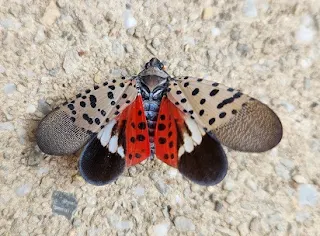 |
| Spotted Lanternfly |
The spotted lanternfly (Lycorma delicatula) is an invasive insect species that is native to China, Vietnam, and other parts of Asia. It was first detected in the United States in 2014, and has since spread to multiple states in the eastern US, causing damage to trees and crops. The spotted lanternfly feeds on the sap of plants, and can cause wilting, dieback, and even death of the host plants. In addition to the economic impact on agriculture, the spotted lanternfly can also be a nuisance to homeowners due to its tendency to swarm and its sticky excrement, which can create a mess as well as sooty black mold
growth.
The tree-of-heaven
(Ailanthus altissima) is a non-native invasive tree species that is known to be a preferred host for the spotted lanternfly. Tree-of-heaven trees can grow up to 80 feet tall, and produce a large amount of seeds that can spread rapidly, allowing them to dominate and displace other plant species. Tree-of-heaven is often found in urban and suburban areas, where it is used as a street tree, and in landscaped areas and lawns. The large population of tree-of-heaven trees in these areas provides an ideal habitat for the spotted lanternfly, which can rapidly increase its population.The anti-lawn seeks to reduce the amount of turfgrass in urban and suburban areas, and promote the use of native plants, trees, and shrubs instead. Lawns are often seen as an unnecessary and environmentally harmful feature of urban and suburban landscapes, as they require large amounts of water, fertilizer, and pesticide to maintain, and contribute to soil erosion, water pollution, and the loss of biodiversity. By replacing lawns with native plants and trees, the anti-lawn movement seeks to create a more sustainable and ecologically balanced landscape.
By reducing the amount of tree-of-heaven trees in urban and suburban areas, the anti-lawn movement can indirectly contribute to controlling the spread of the spotted lanternfly. Native plants and trees are less likely to be a host for the insect, and can provide a more diverse and healthy ecosystem that supports beneficial insects and other wildlife. Additionally, reducing the use of pesticides on lawns can also indirectly help control the spread of the spotted lanternfly by protecting beneficial insects that prey on the insect such as bees, wasps, wheelbugs, spiders, snakes, birds, etc.
The impact of the spotted lanternfly on agriculture has been significant, with losses estimated to be in the millions of dollars. The insect can attack a wide variety of crops, including grapes, apples, peaches, hops, and hardwood trees. The damage caused by the spotted lanternfly can lead to reduced yields and quality of crops, as well as increased costs for pest control measures. In addition to the economic impact, the spread of the spotted lanternfly also has ecological consequences, as it can displace native plant and animal species, and disrupt the balance of ecosystems.
Controlling the spread of the spotted lanternfly is a complex issue that requires a multifaceted approach. In addition to the indirect contributions of the anti-lawn movement, there are several other strategies that can be used to control the spread of the insect. One approach is to focus on early detection and rapid response, which involves monitoring for the presence of the insect, and implementing measures to control its spread. This can include the use of sticky bands to trap and remove the insect, as well as the use of pesticides and other chemical treatments, which we personally would not recommend as first line due to the potential environmental and health effects.
Another approach is to promote biological control measures, which involve using natural predators and parasitoids to control the population of the insect. This can include the release of predatory insects, such as the Chinese mantis and the wheel bug, which feed on the spotted lanternfly.

No comments:
Post a Comment